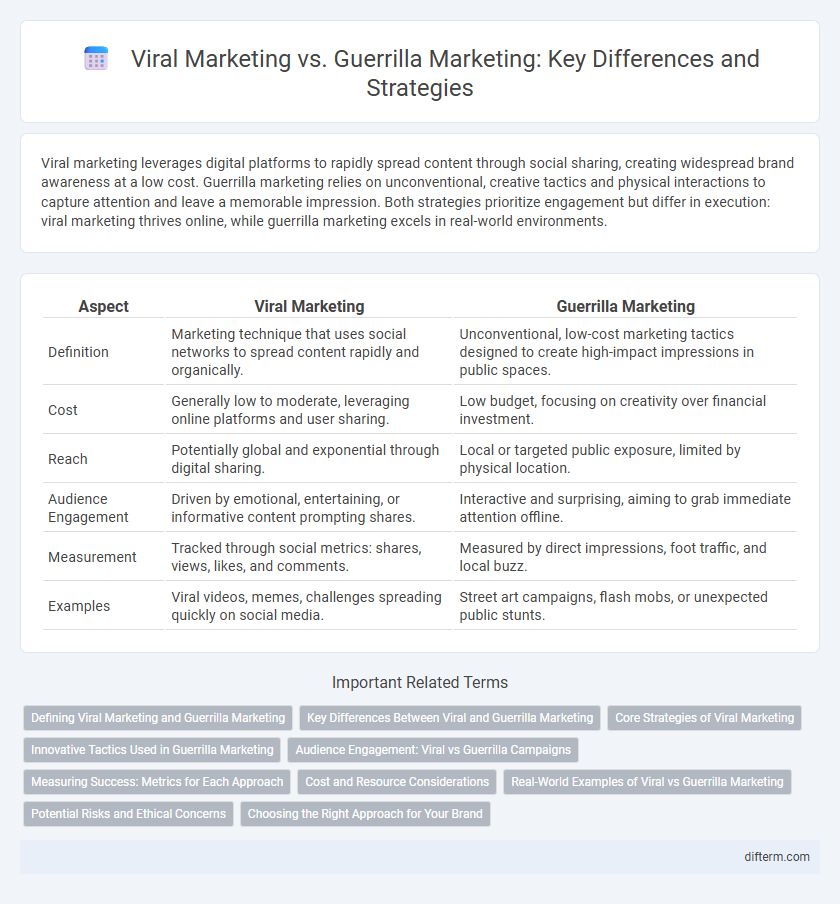Viral marketing leverages digital platforms to rapidly spread content through social sharing, creating widespread brand awareness at a low cost. Guerrilla marketing relies on unconventional, creative tactics and physical interactions to capture attention and leave a memorable impression. Both strategies prioritize engagement but differ in execution: viral marketing thrives online, while guerrilla marketing excels in real-world environments.
Table of Comparison
| Aspect | Viral Marketing | Guerrilla Marketing |
|---|---|---|
| Definition | Marketing technique that uses social networks to spread content rapidly and organically. | Unconventional, low-cost marketing tactics designed to create high-impact impressions in public spaces. |
| Cost | Generally low to moderate, leveraging online platforms and user sharing. | Low budget, focusing on creativity over financial investment. |
| Reach | Potentially global and exponential through digital sharing. | Local or targeted public exposure, limited by physical location. |
| Audience Engagement | Driven by emotional, entertaining, or informative content prompting shares. | Interactive and surprising, aiming to grab immediate attention offline. |
| Measurement | Tracked through social metrics: shares, views, likes, and comments. | Measured by direct impressions, foot traffic, and local buzz. |
| Examples | Viral videos, memes, challenges spreading quickly on social media. | Street art campaigns, flash mobs, or unexpected public stunts. |
Defining Viral Marketing and Guerrilla Marketing
Viral marketing leverages digital platforms to create highly shareable content that spreads rapidly among targeted audiences, driven by social sharing and word-of-mouth. Guerrilla marketing employs unconventional, low-cost strategies in physical or public spaces to capture attention and create memorable brand experiences. Both approaches aim to maximize engagement, but viral marketing relies on online amplification while guerrilla marketing emphasizes impactful, real-world interactions.
Key Differences Between Viral and Guerrilla Marketing
Viral marketing leverages digital platforms and social sharing to rapidly spread content through user engagement, while guerrilla marketing relies on unconventional, often low-cost physical stunts or experiences to create memorable brand impressions. Viral campaigns focus on scalability and online reach, utilizing tools like social media algorithms and influencer networks for exponential growth. Guerrilla marketing emphasizes creative, localized tactics that directly capture consumer attention in public spaces, driving immediate impact through surprise and originality.
Core Strategies of Viral Marketing
Viral marketing leverages digital platforms and social sharing behaviors to rapidly disseminate branded content, emphasizing emotionally compelling messages that encourage users to share organically. Core strategies include creating highly engaging, shareable videos, memes, and interactive content that tap into social networks' algorithms, maximizing reach without high advertising costs. Unlike guerrilla marketing's unconventional, physical stunts aimed at surprise and local impact, viral marketing prioritizes scalable online engagement driven by user-generated amplification.
Innovative Tactics Used in Guerrilla Marketing
Guerrilla marketing employs unconventional, low-cost tactics such as street art, flash mobs, and interactive installations to create memorable brand experiences that engage audiences directly in public spaces. These innovative strategies leverage surprise and creativity to generate organic buzz, often resulting in high social sharing and word-of-mouth promotion. Unlike viral marketing, which relies heavily on digital platforms and content to spread rapidly online, guerrilla marketing focuses on physical presence and real-world impact to captivate consumers.
Audience Engagement: Viral vs Guerrilla Campaigns
Viral marketing campaigns leverage social media and digital shareability to rapidly engage a broad audience through highly relatable or entertaining content. Guerrilla marketing relies on unconventional, memorable physical stunts or installations to create direct, emotionally charged interactions that capture local attention. Audience engagement in viral campaigns often scales globally with measurable online metrics, while guerrilla campaigns drive deep, localized impact through face-to-face experiences.
Measuring Success: Metrics for Each Approach
Viral marketing success is often measured by metrics such as share rate, reach, engagement levels on social media platforms, and the number of organic impressions generated. Guerrilla marketing effectiveness is assessed through direct impact indicators like foot traffic, event participation, and local brand awareness increases. Both strategies benefit from analyzing conversion rates and customer acquisition costs to evaluate overall return on investment.
Cost and Resource Considerations
Viral marketing leverages digital platforms to achieve rapid, wide-reaching exposure with minimal upfront costs, primarily relying on engaging content and social sharing to reduce resource expenditure. Guerrilla marketing often demands more creative planning, physical materials, and unconventional tactics, which can increase upfront investment but potentially create lasting brand impressions through high-impact, localized campaigns. Businesses must weigh the low-cost scalability of viral approaches against the tangible, immersive experiences offered by guerrilla strategies to align marketing budgets with desired campaign outcomes.
Real-World Examples of Viral vs Guerrilla Marketing
Wendy's 2017 Twitter roast storm exemplifies viral marketing through rapid user engagement and content sharing, generating millions of impressions online. In contrast, Coca-Cola's "Small World Machines" campaign used guerrilla marketing by installing interactive vending machines in India and Pakistan to promote unity through real-time human connection. Both strategies leverage emotional appeal and creativity but differ in platform focus and audience interaction methods.
Potential Risks and Ethical Concerns
Viral marketing campaigns risk losing control over message accuracy, potentially leading to brand misrepresentation and negative public backlash. Guerrilla marketing tactics can raise ethical concerns if they involve deception, intrusive public behavior, or unauthorized use of public spaces, resulting in legal issues and damaged reputation. Both strategies require careful planning to balance innovation with transparency and respect for audience sensitivity.
Choosing the Right Approach for Your Brand
Viral marketing leverages social media and online platforms to rapidly spread branded content through shareable, engaging materials, achieving widespread reach at a relatively low cost. Guerrilla marketing emphasizes unconventional, creative, and often localized tactics to capture attention and generate buzz, making it ideal for brands seeking direct, memorable customer interactions. Selecting the right approach depends on your brand's target audience, budget constraints, and campaign goals, with viral marketing suited for scalable digital presence and guerrilla marketing excelling in impactful, experiential engagement.
viral marketing vs guerrilla marketing Infographic

 difterm.com
difterm.com